Getting online data to offline communities
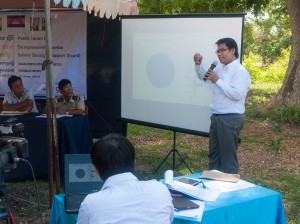
Bringing online data to a rural, offline community (photo: Kyle James)
Data journalism has opened up new ways of telling compelling stories, finding connections and creating visuals that explain important, complex issues is easy-to-understand ways.
This has become possible through the huge range of digital information now available online. While much of that information is presented online and sometimes in newspapers and magazines, what about communities who don’t have much access to the internet or even printed media?
Are these communities, often poor and rural, simply going to miss out on the results and benefits of data journalism? Not necessarily. onMedia’s Kyle James looks at a project in Cambodia that has been linking online and offline communities – with promising results.
Early this year, 13 young Cambodians working in the media and communication sectors gathered in the capital Phnom Penh for a data-driven journalism workshop. They were looking for stories related to their country’s social and political development. But instead of hitting the streets with notepads, recorders and cameras, they flipped open laptops and started digging in databases, online archives and other digital information sources.
While data journalism is taking off in Cambodia like it is in many parts of the world, for a lot of people in the country, going online to see the results of data analysis or opening a paper to see a chart or graph is simply not possible. Some 80 percent of Cambodians live in the countryside—and many of them aren’t connected to the electricity grid. While some people there do get online with their smartphones, most don’t. Newspapers in Cambodia seldom reach many areas outside the main urban centers.
But it is possible to link up this information found online with people living in offline environments, as a project carried out earlier this year by the German development agency GIZ, DW Akademie and several local groups showed.
And it’s not exactly rocket science; it just involves getting data into the kinds of information channels rural people can access.
Getting good data
At the data-driven journalism workshop organized by DW Akademie, participants scoured online resources like news archives, NGO reports, government websites, social media and blogs. They also dove into open-data sites such as Open Development Cambodia (ODC), which aggregates and disseminates publically available data on development trends in the country. (Check out the onMedia post on ODC from last year.)
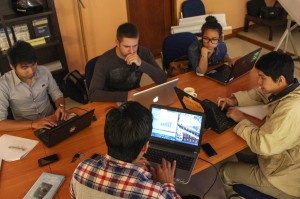
Crunching data at the data journalism workshop (photo: Ly You Y)
The results of their research were compiled and put into a multimedia, interactive, data-driven journalism blog. It features data stories on falling rice prices, the high number of accidents on Cambodian roads, sex workers, among other topics.
One data story on the blog is about the difficulties in getting passports and IDs in Cambodia. It’s a crucial issue since so many Cambodians migrate to Thailand for work. They often go without any legal documentation since they don’t know even how to get the papers. And the hurdles, including the costs, are often too high.
The report features graphs comparing passport fees in ASEAN countries, statements from citizens, info about “unofficial” fees (i.e. bribes often asked for by officials and passport brokers), and other data. The challenge was to get that information to the communities most affected as well as to government officials, not just to have it circulating among the young and tech savvy in the cities.
Hitting the target audience
Fast forward a few months and from a wifi-equipped seminar room in Phnom Penh to a clearing outside a pagoda accessible only by dirt road. Some 75 people, mostly rice farmers and unskilled laborers, gathered under a canopy that gave welcome protection from the blistering Cambodian sun.
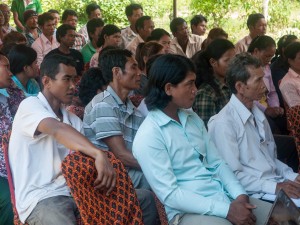
Rural Cambodians listen to info on passports provided by data journalists (photo: Kyle James)
They were here for a public forum on passports and IDs and to hear from the four local officials who had come to speak, and hopefully listen. As the moderator pointed to a screen set up in front, the villagers craned their necks for a better look.
They saw bar graphs and pie charts from the data story that showed how passport prices compare in the region, how long people in different countries have to work to afford one, and the wide gulf between the official passport price and how much people actually end up paying for one.
The moderators had translated the information graphics into Khmer, put them on a USB stick, brought them to the provinces and projected them onto the screen.
No broadband required.
“The visualized data reached people in a friendly and understandable way,” said Tep Bunthan, a manager at the Women’s Media Centre of Cambodia (WMC), a radio and TV broadcaster, and one of the moderators. “The graphs helped people take part in productive discussions.”
After the information session, there was a lively round of questions and opinions for the local policymakers. Equipped with new information, the villagers asked the officials outright to explain why passports cost more in Cambodia than in richer Southeast Asian countries. Several of the officials offered practical advice on getting passports and how to avoid being price gouged by brokers. They promised to take action to make the process easier.
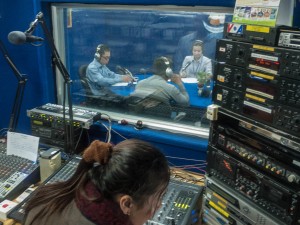
A radio call-in show got the data to a wide audience (photo: Kyle James)
The forum was recorded and broadcast live on WMC, greatly increasing its reach. A few weeks later the broadcaster held a radio call-in show on the same topic, again using information from the data workshop, but talking to national-level officials this time. The moderator also wanted to follow up on the forum. Was the government putting its money where its mouth was?
Finally, to complete the circle, portions of the recordings of the forum and the call-in show were edited down put on the WMC website via Soundcloud and will soon go on the data journalism workshop blog, which will remain online to serve as a resource for people researching development topics in Cambodia.
That means the data journalism workshop blog will benefit from the voices of real people who are affected by the issue. Its data stories will be that much richer.
It’s about access
The goal of the project is to provide better access to information to people who don’t have all that much. The information on passports and other development topics gathered by the young journalists in the data workshop was great, but it was unlikely to reach many communities outside the capital.
But simply putting relevant information onto a slide and taking it to the communities themselves and then creating a radio program got the data out there to a much wider audience. Sure, it took more effort than putting it on a blog (especially that last bit of very bumpy ride out to the village), but not everyone has a computer or smartphone or even knows how to get online, especially in many rural parts of the developing world.
And not everyone in rural Cambodia reads, so in this case it was important to have someone explain the charts. But the bar graph format helped make it clear to everyone, regardless of reading level.
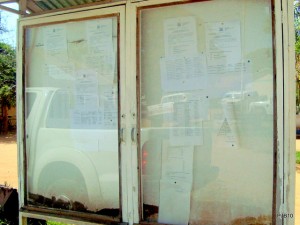
Use the channels through which offline communities get their info (photo: flickr/Peter J. Bury CC:BY-NC-SA)
While this project has used slides and old-fashioned radio, you could also print out informational graphics on paper, hand them out or post them in a central gathering place (of course, taking the literacy rate into account).
Perhaps people in the area get their information by word of mouth. So, another possibility would be to share the data with a local village leader or someone who can be trusted to pass along good information to others.
Sometimes and in some places, a low-tech approach is the best one.
Linking these online and offline worlds has brought tangible benefits to rural Cambodians. At the same time, it’s letting people accessing the information on the internet hear to the experiences of people they probably wouldn’t have been able to otherwise. I’d say it’s a win-win.
The data journalism/information access project had a great deal of help from its cooperation partners: the Women’s Media Centre (WMC), Open Development Cambodia and the Cambodian Center for Human Rights.
Author: Kyle James



